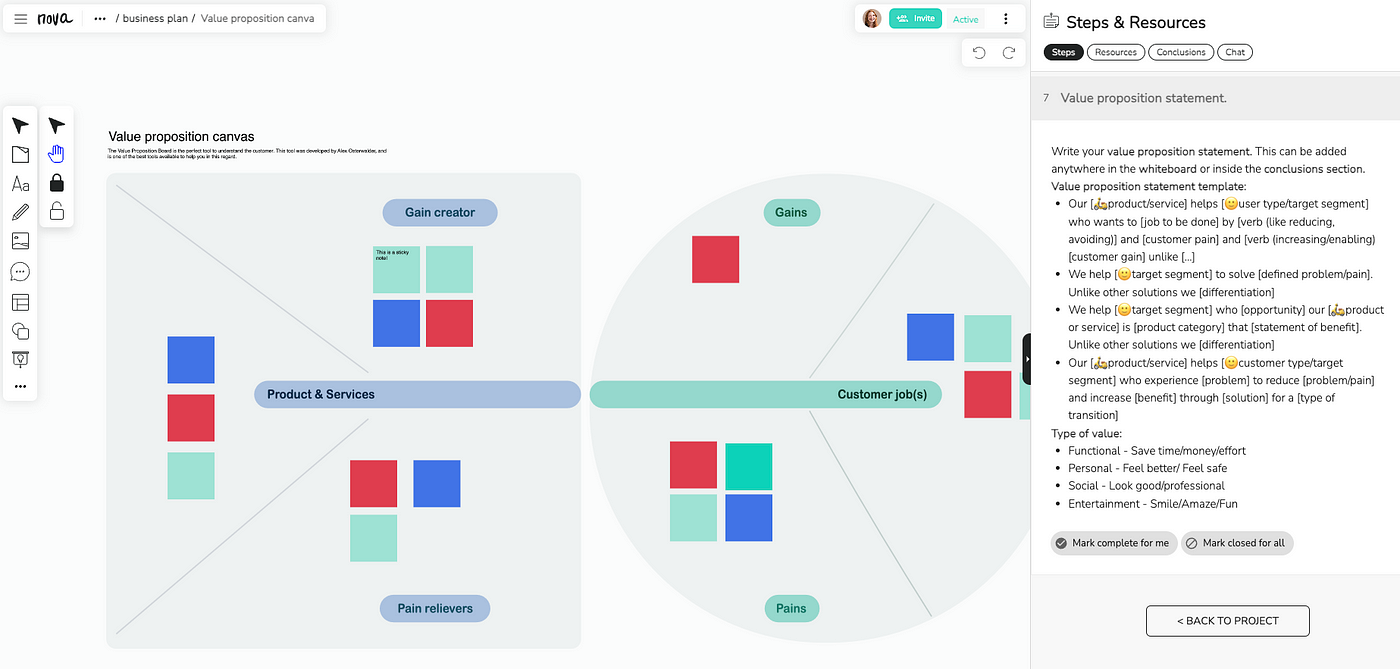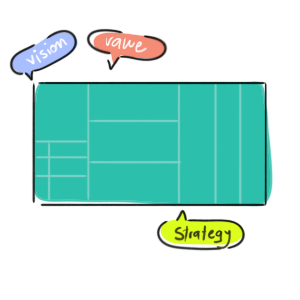Value Proposition Canvas: Unlock Your Value Proposition
The Value Proposition Canvas is a tool designed to ensure that a product or service is positioned around what the customer values and needs. It’s a focused extension of the Business Model Canvas by Alexander Osterwalder. Understanding and using this canvas can significantly improve your strategic thinking and help you create and deliver value.

Objective: Create and deliver value.
Understanding the Value Proposition Canvas
The canvas is split into two main parts:
1. Customer Profile:
- Customer Jobs: What tasks are your customers trying to perform and what problems are they trying to solve? This can include functional, social, or emotional jobs.
- Pains: What frustrations, obstacles, or risks do your customers face while trying to accomplish these jobs?
- Gains: What benefits and values do your customers desire? What would make their job easier, or make them happier?
Important Tips: Pains
When developing a solution or business, understanding user pains — the problems, challenges, and frustrations that users face — is crucial. Effectively identifying and addressing these pains can significantly enhance the value of your product or service and improve customer satisfaction. Here’s how you should think about user pains when defining a solution or business:
Types of User Pains
User pains can generally be categorized into a few broad types:
- Functional Pains: These relate to the specific tasks users are trying to accomplish or the functional problems they encounter with current solutions. Examples include inefficiencies, poor usability, or lack of functionality.
- Financial Pains: These are concerned with the costs associated with using a solution, whether those costs are monetary, time-related, or resource-intensive. Users may feel that a product is too expensive, not worth the cost, or that it requires too much investment for the return it provides.
- Social Pains: These involve the way a product or service affects a user’s social interactions or standing. For example, users might worry about how using a product will be perceived by others, or they might feel a product doesn’t fit their identity.
- Emotional Pains: These are related to users’ feelings about their interactions with a product or service. This can include frustrations with customer service, the stress of complex interfaces, or anxiety about reliability.
- Process Pains: These pains occur when existing solutions complicate processes or workflows. Users might be frustrated by solutions that integrate poorly with other tools, have steep learning curves, or require cumbersome steps to achieve results.
Thinking About User Pains
To effectively address user pains, consider the following steps:
- Empathize with Your Users: Start with qualitative research such as interviews, focus groups, and ethnographic studies. Spend time understanding who your users are, what their days look like, and where their points of friction lie. Persona development and empathy mapping are useful tools in this phase.
- Identify and Validate Pains: Through your research, compile a list of potential user pains. Validate these pains by observing users in their environment or by asking targeted questions that let you measure the frequency and intensity of these pains. Surveys and A/B testing can also provide data on how widespread and critical these pains are.
- Prioritize Pains: Not all user pains are equally important. Prioritize them based on their impact on the user’s experience and the frequency with which they occur. Focus on pains that, when solved, will provide the most value and satisfaction to your users.
- Develop Pain Relievers: For each significant pain point, brainstorm potential solutions. These solutions should directly address the pain in a way that is noticeable and meaningful to the user. This stage often involves creative problem-solving to find novel or improved ways to alleviate these pains.
2. Value Map:
- Products and Services: What are you offering to the customer? List the features of your products or services.
- Pain Relievers: How does your product alleviate specific customer pains? These should directly address the frustrations your customers face.
- Gain Creators: How does your product create gains for the customer? This could be through offering superior features, benefits, or enhancements that go beyond just solving a problem.
Value proposition:
- Our [🛵product/service] helps [🙂user type/target segment] who wants to [job to be done] by [verb (like reducing, avoiding)] and [customer pain] and [verb (increasing/enabling) [customer gain] unlike […]
- We help [🙂target segment] to solve [defined problem/pain]. Unlike other solutions we [differentiation]
Here is a quick video.
The thinking process.
Thinking strategically about your value proposition and driving innovation requires deep inquiry into your business and its interaction with customers. Here are some thought-provoking questions that can help refine your value proposition and inspire innovative ideas:
Who are our customers “really”?
- Have we fully understood the demographic and psychographic profiles of our target market?
- Are there underserved customer segments that we haven’t considered yet?
What do our customers truly value?
- What are the non-obvious desires and needs of our customers?
- How might these needs evolve in the future?
What jobs are our customers trying to get done?
- Are there jobs our customers are struggling with that no current offerings address?
- Can we identify any jobs-to-be-done that are emerging due to changes in technology, society, or regulations?
What pains are our customers experiencing?
- Which customer pains are most intense and therefore most impactful to address?
- Are there pains that customers have resigned themselves to that we might eliminate?
What gains are our customers seeking?
- What are the ultimate benefits our customers hope to gain from completing their jobs?
- Are there gains that our customers have not yet imagined that we can provide?
How are current solutions underperforming for our customers?
- Where do existing products or services fall short in satisfying customer needs?
- What are the most frequent complaints or frustrations with current market offerings?
How can we eliminate or reduce customer pains in ways that others can’t?
- What innovative approaches can we employ to address these pains?
- Can technology, unique partnerships, or new business models offer new pain relievers?
How can we create gains that are superior to the competition?
- What can we offer that would delight customers, possibly creating a wow factor?
- How can we exceed customer expectations in a manner that is difficult for competitors to replicate?
What’s the minimum viable product (MVP) that would test our new value proposition?
- What features must this MVP have to adequately relieve pain and create gain?
- How can we use the MVP to learn the most about customer preferences with the least effort?
How does our value proposition fit within the broader trends in the industry?
- Are there macroeconomic, social, or technological trends that support or threaten our value proposition?
- How might we leverage these trends to enhance our offering?
What assumptions are we making about our customers and market?
- Which assumptions are the riskiest, and how can we test them quickly and cheaply?
- How can we incorporate continuous customer feedback to challenge and refine these assumptions?
How scalable is our value proposition?
- If our solution succeeds, how easily can it be scaled regionally, nationally, or globally?
- What barriers to scaling might we encounter, and how can we mitigate them early on?
These questions are designed to push your thinking and help you uncover new ways to add value for your customers.
The Value Proposition Canvas is more than just a tool; it’s a mindset shift towards aligning your business more closely with the needs of your customers. It helps you think beyond features and to delve into the actual benefits your customers seek, thereby enhancing both product development and communication strategy.
Using this canvas can be a transformative step towards making your business more focused, competitive, and responsive to customer needs.
As we conclude our deep dive into the Value Proposition Canvas, it’s clear that this tool is not just a method for aligning your offerings with customer needs — it’s a critical framework for innovating and staying competitive in a rapidly changing market. The insights you can gain from this canvas are invaluable, whether you’re tweaking an existing product or launching a new venture.
I encourage you to not only apply this tool within your own business context but to share it with peers, colleagues, and anyone embarking on their entrepreneurial journey. The collaborative potential of the Value Proposition Canvas can transform individual insights into collective wisdom, amplifying its impact.
To make this process as accessible as possible, I’m thrilled to offer the Value Proposition Canvas for free at Nova. This is a resource for all entrepreneurs and business strategists who want to refine their market approach and deliver superior value to their customers.
Please, take this tool, use it, share it, and explore how it can clarify and enhance your business strategy.
By sharing these resources, we can help each other grow stronger and more responsive to our customers’ needs.
Visit us at Nova to access your free Value Proposition Canvas, and start transforming your business ideas into reality today.


